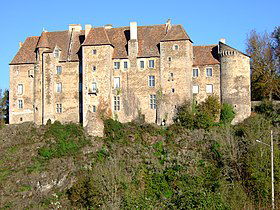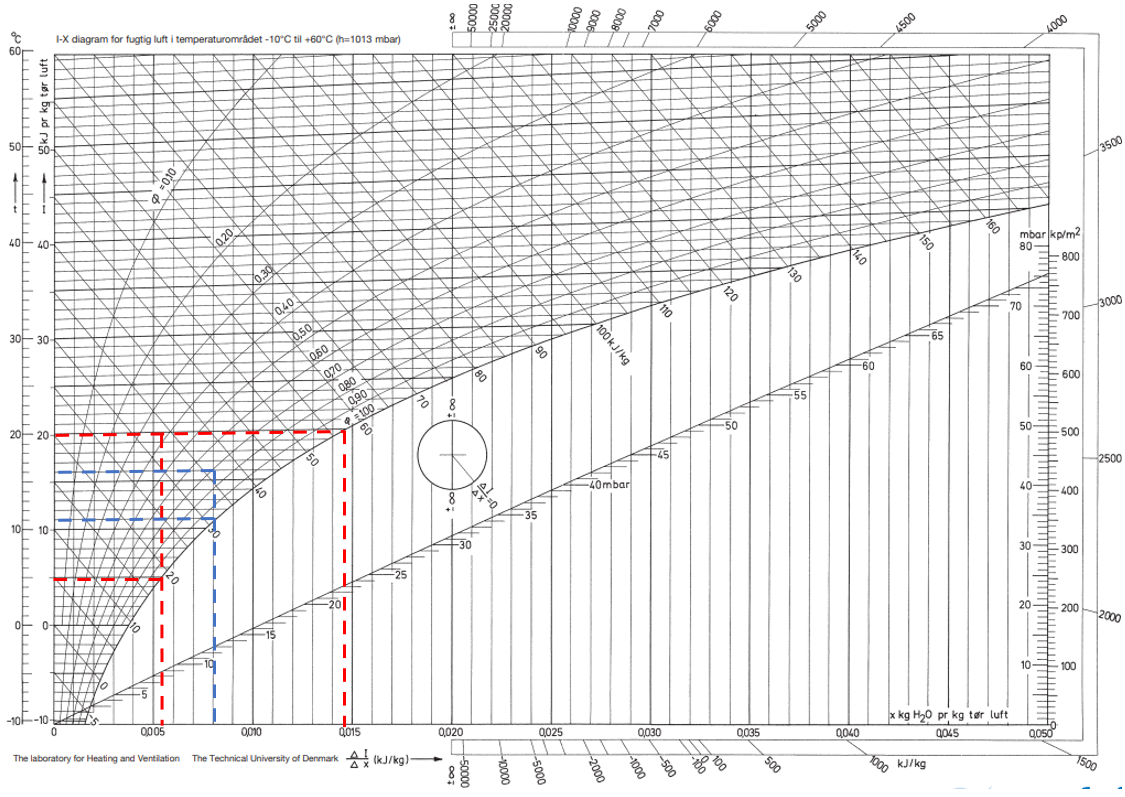Fugt i et gammelt fransk slot

Af Uffe Jespersen, februar 2022
Avoiding moisture problems indoor
As described belove the humidity in a house is depending on:
- The moisture added to the air from activities in the house
- The room temperature
- The air change (ventilation)
- The humidity in the outside air used to ventilate the house
In a castle I assume that the windows and doors are old and not very airtight and the area and volume inside is large compared to the people in the house. Which means that under normal conditions the natural ventilation will remove the moisture added. It might though be a good idea to extract air from bath and kitchen activities. To avoid problems with moisture when the castle is not in use, the basic solution is to increase the room temperature to some 5 °C above the outside temperature to secure that the humidity in the room is below 70 % RH. And avoid putting furniture next to the outside and cold walls, since this will lower the surface temperature because the furniture would act as insulation. This method can be supported by a simple hygrometer to monitor the humidity in the indoor air.
Basic theory:
Relative humidity:
The relative humidity expresses the amount of water in the air in relation to the amount of water the air can contain in total. At 20°C the air can contain 14,5 g water (per kg dry air), and if the air has an absolute humidity of 5,5 g water (per kg dry air), the relative humidity is 38 % RH. The amount of water that the air can contain various with the temperature – e.g., at 5°C the air can contain 5,5 g water (per kg dry air), and in the example above the relative humidity would then be 100 % RH. See the red lines in the IX-diagram below (also known as a Mollier diagram). The humidity becomes a problem indoor if the relative humidity becomes higher than some 80 % RH on a given surface/part of the building – typically on a window or outside wall. And since these surfaced are normally a couple of degrees colder than the room temperature, the relative humidity in the room should be below 70 % RH.

Dewpoint:
The dewpoint expresses the temperature at which the relative humidity is 100 % RH and the moisture in the air will condensate. Assuming that the outside air is 5°C and has a relative humidity of 90 % RH (which is normal in winter) the absolute humidity is 5 g water (per kg dry air) – and that air is used to ventilate the house. With a normal air change (0,5 times air change per hour) a 4-person family in a 100 m2 house will add some 3 g water (per kg dry air) from simple living activities. Which brings the absolute humidity in the house to 8 g water (per kg dry air) and that corresponds to a dew point of 11°C (equal to 100 % RH). This means that in order to keep the humidity in the room below 70 % RH, the room temperature must be above 16 °C (from IX-diagram). The dewpoint inside is depending on the humidity in the outside air, the humidity added in the house and the change of air (ventilation).
Heat transfer and storage (heat load):
When there is a temperature difference between outside and inside, heat will go from the inside to the outside through construction parts (walls, windows, doors, roof). The speed of this heat transfer depends on temperature difference and heat insulation of the construction part. All construction parts have a certain resistance to heat transfer (insulation value) and obviously a wall with a thick layer of insulation will have a higher resistance than a simple concrete wall. On top of that the resistance from air to surface is (approximately) the same for different types of walls, which means that in the badly insulated wall this resistance will be a higher part of the total resistance – resulting in a lower surface temperature on the inside. Even though a stone wall has a low heat transfer resistance, the resistance increases with the thickness of the wall.

Various materials have different heat storage capacities. E.g stone and concrete can contain much more heat than mineral wool, gypsum, and wood. This influences how fast heating (or cooling) will affect the change in indoor air temperature, since the material will take up the heat – a wooden house reacts faster than a stone house. A house with thick stone walls will take long time to heat up, but it also keeps the heat for a longer time. And the internal surface temperature of the outside walls is not as low as one would expect once the room is heated up.
Ventilation
In general, there are three types of ventilation:
- Natural ventilation: This is mainly fresh air entering the house through areas in the construction with low airtightness. E.g., through windows and doors. This kind of ventilation depends on the wind outside – more wind will create more ventilation.
- Extract ventilation: In this kind of ventilation fans for instance in toilets extracts the polluted air and makes an under pressure in the house that will make fresh air come in through cracks or ventilation openings.
- Balanced extract and supply air: This is the more advanced and modern type of ventilation where two fans will both secure the extraction and supply of air. This is normally done in an Air Handling Unit and often combined with a heat exchanger to take heat/energy from extract and use it to preheat the supply air. It can also be combined with heating and cooling to create a complete air conditioning system. This kind of ventilation would require a complex system of ventilation ducts installed in the house.
An error that is often seen in renovation is when old and untight windows and doors are replaced without at the same time considering the ventilation principle. If the existing system of natural ventilation is kept, the air change will be changed dramatically and causing the humidity to build up in the house – the dewpoint temperature will increase and thus the indoor air quality will be severely changed. In a standard apartment with 4 persons an air change of 0,5 times per hour would normally be sufficient to secure a good indoor air quality. This will give an air flow of 125 m3/h (100 m2 [area]* 2,5 m [height] * 0,5 times per hour [air change]) or some 30 m3/h per person. If the 4 persons live in a bigger house with a higher ceiling height the air change can be reduced:
Area = 200 m2; Height = 3 m; 4 persons; 30 m3/h per person => air change = 0,2 times per hour